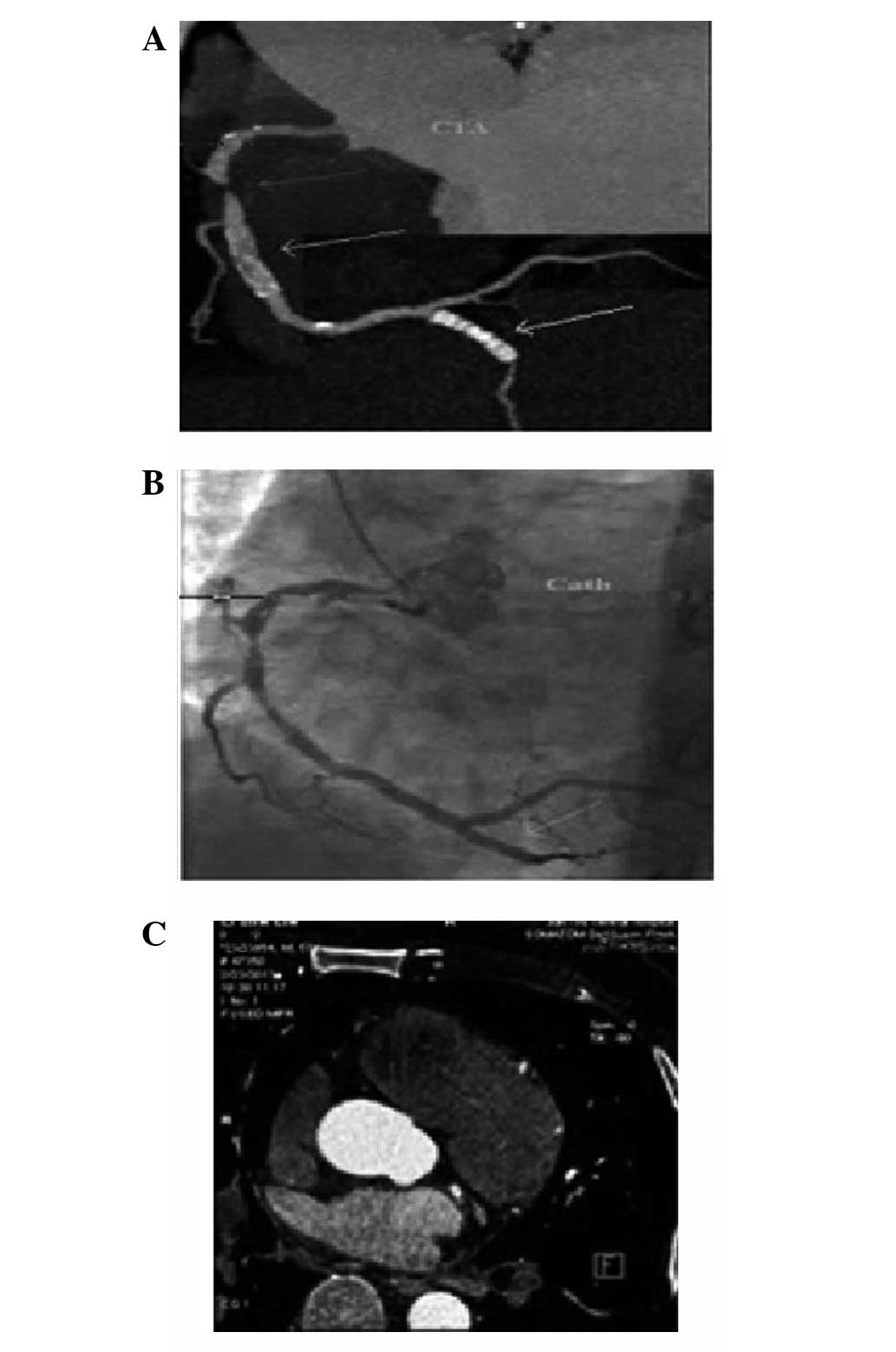|
1
|
Sampson UK, Dorbala S, Limaye A, et al:
Diagnostic accuracy of rubidium-82 myocardial perfusion imaging
with hybrid positron emission tomography/computed tomography in the
detection of coronary artery disease. J Am Coll Cardiol.
49:1052–1058. 2007. View Article : Google Scholar
|
|
2
|
Go RT, Marwick TH, MacIntyre WJ, et al: A
prospective comparison of rubidium-82 PET and thallium-201 SPECT
myocardial perfusion imaging utilizing a single dipyridamole stress
in the diagnosis of coronary artery disease. J Nucl Med.
31:1899–1905. 1990.
|
|
3
|
Ruzsics B, Lee H, Zwerner PL,
Gebregziabher M, Costello P and Schoepf UJ: Dual-energy CT of the
heart for diagnosing coronary artery stenosis and myocardial
ischemia-initial experience. Eur Radiol. 18:2414–2424. 2008.
View Article : Google Scholar : PubMed/NCBI
|
|
4
|
Ruzsics B, Lee H, Powers ER, Flohr TG,
Costello P and Schoepf UJ: Images in cardiovascular medicine.
Myocardial ischemia diagnosed by dual-energy computed tomography:
correlation with single-photon emission computed tomography.
Circulation. 117:1244–1245. 2008. View Article : Google Scholar
|
|
5
|
Stolzmann P, Leschka S, Scheffel H, et al:
Dual-source CT in step-and-shoot mode: noninvasive coronary
angiography with low radiation dose. Radiology. 249:71–80.
2008.PubMed/NCBI
|
|
6
|
Abdulla J, Abildstrom SZ, Gotzsche O,
Christensen E, Kober L and Torp-Pedersen C: 64-multislice detector
computed tomography coronary angiography as potential alternative
to conventional coronary angiography: a systematic review and
meta-analysis. Eur Heart J. 28:3042–3050. 2007. View Article : Google Scholar
|
|
7
|
Hendel RC, Patel MR, Kramer CM, et al;
American College of Cardiology Foundation Quality Strategic
Directions Committee Appropriateness Criteria Working Group;
American College of Radiology; Society of Cardivascular Computed
Tomography; Society of Cardiovascular Magnetic Resonance; American
Society of Nuclear Cardiology; North American Society for Cardiac
Imaging; Society for Cardiovascular Angiography and Interventions;
Society of Interventional Radiology.
ACCF/ACR/SCCT/SCMR/ASNC/NASCI/SCAI/SIR 2006 appropriateness
criteria for cardiac computed tomography and cardiac magnetic
resonance imaging: a report of the American College of Cardiology
Foundation Quality Strategic Directions Committee Appropriateness
Criteria Working Group, American College of Radiology, Society of
Cardivascular Computed Tomography, Society of Cardiovascular
Magnetic Resonance, American Society of Nuclear Cardiology, North
American Society for Cardiac Imaging, Society for Cardiovascular
Angiography and Interventions, and Society of Interventional
Radiology. J Am Coll Cardiol. 48:1475–1497. 2006.
|
|
8
|
Beck T, Burgstahler C, Reimann A, et al:
Technology insight: possible applications of multislice computed
tomography in clinical cardiology. Nat Clin Pract Cardiovasc Med.
2:361–368. 2005. View Article : Google Scholar : PubMed/NCBI
|
|
9
|
Johnson TR, Krauss B, Sedlmair M, et al:
Material differentiation by dual energy CT: initial experience. Eur
Radiol. 17:1510–1517. 2007. View Article : Google Scholar : PubMed/NCBI
|
|
10
|
Feuchtner G, Goetti R, Plass A, et al:
Adenosine stress high-pitch 128-slice dual source myocardial
computed tomography perfusion for imaging of reversible myocardial
ischemia: comparison with magnetic resonance imaging. Circ
Cardiovasc Imaging. 4:540–549. 2011.
|
|
11
|
Cerqueira MD, Weissman NJ, Dilsizian V, et
al; American Heart Association Writing Group on Myocardial
Segmentation and Registration for Cardiac Imaging. Standardized
myocardial segmentation and nomenclature for tomographic imaging of
the heart. A statement for healthcare professionals from the
cardiac imaging committee of the council on clinical cardiology of
the American Heart Association. Circulation. 105:539–542. 2002.
View Article : Google Scholar
|
|
12
|
Kachenoura N, Gaspar T, Lodato JA, et al:
Combined assessment of coronary anatomy and myocardial perfusion
using multidetector computed tomography for the evaluation of
coronary artery disease. Am J Cardiol. 103:1487–1494. 2009.
View Article : Google Scholar
|
|
13
|
Scheffel H, Alkadhi H, Plass A, et al:
Accuracy of dual source CT coronary angiography: first experience
in high pretest probability population without heart rate control.
Eur Radiol. 16:2739–2747. 2006.PubMed/NCBI
|
|
14
|
Crossman DC: The pathophysiology of
myocardial ischaemia. Heart. 90:576–580. 2004. View Article : Google Scholar : PubMed/NCBI
|
|
15
|
Jayaweera AR, Wei K, Coggins M, Bin JP,
Goodman C and Kaul S: Role of capillaries in determining CBF
reserve: new insights using myocardial contrast echocardiography.
Am J Physiol. 277:H2363–H2372. 1999.PubMed/NCBI
|
|
16
|
Wang R, Yu W, Wang Y, et al: Incremental
value of dual-energy CT to coronary CT angiography for the
detection of significant coronary stenosis: comparison with
quantitative coronary angiography and single photon emission
computed tomography. Int J Cardiovasc Imaging. 27:647–656. 2011.
View Article : Google Scholar
|
|
17
|
Blankstein R, Shturman LD, Rogers IS, et
al: Adenosine-induced stress myocardial perfusion imaging using
dual-source cardiac computed tomography. J Am Coll Cardiol.
54:1072–1084. 2009.PubMed/NCBI
|
|
18
|
Schwarz F, Ruzsics B, Schoepf UJ, et al:
Dual-energy CT of the heart: principles and protocols. Eur J
Radiol. 68:423–433. 2008. View Article : Google Scholar : PubMed/NCBI
|
|
19
|
Gaemperli O, Schepis T, Valenta I, et al:
Cardiac image fusion from stand-alone SPECT and CT: clinical
experience. J Nucl Med. 48:696–703. 2007. View Article : Google Scholar : PubMed/NCBI
|
|
20
|
Berman DS, Hachamovitch R, Shaw LJ, et al:
Roles of nuclear cardiology, cardiac computed tomography, and
cardiac magnetic resonance: assessment of patients with suspected
coronary artery disease. J Nucl Med. 47:74–82. 2006.
|











